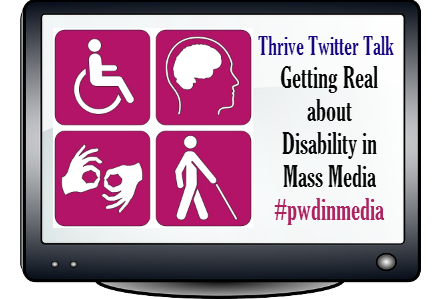Highlights from a #PWDinmedia chat (that’s people with disabilities in media for the non-Tweeters)
by Yolanda
 We are immersed in a world of pop culture.
We are immersed in a world of pop culture.
This kind of world is great when you want to come home from a rough day and catch up on your favorite shows and movies on Netflix. But it can be disheartening when you’ve been exposed to the media since the day you were born and never see anyone like you represented in media images, characters and storylines — not even in your favorite shows. What unspoken message does this send?
Thrive, an Easter Seals community for young women with disabilities, focuses on a disability topic every month. In January, all the Oscar buzz and debate surrounding an able-bodied person playing a person with a disability in The Theory of Everything made disability representation the perfect theme for that month. We wanted to provide a space for young people to be honest about what they thought, and we were thrilled to see Twitter was on fire with people itching to voice their opinions on the subject. Journalists, bloggers, novelists, students, activists, as well as people with and without disabilities contributed to an amazing discussion. We reached over 100,000 users with the hashtag #pwdinmedia with about 500 tweets!
In case you missed it, here is one that got a lot of attention:
Q. What are your thoughts on actors/actresses without disabilities playing the roles of people with disabilities in TV & Film?
“It’s often hard for disabled actors to get roles of abled characters. Giving disabled roles to abled actors thus robs disabled actors of the very few roles they’re able to get. So it always bothers me. Also, it’s often very clumsily done. Abled actors may not use canes or wheelchairs the correct way, for example.” – Corinne Duyvis (@corinneduyvis)
“When depicting disability we shouldn’t make people feel like they can ‘get out’ of the disability. I also want to stress over and over and over again that not all disabilities are ‘tragic’ and ‘life changing.’ I was born blind.” – Elsa S. Henry (@snarkbat)
“I want to see people born with disabilities play themselves too. Not just stories of those who had accidents.” – Schwartz Abdul (@schwartzabdul)
And then there was this one:
Q. What ways has the media shown progress towards disability representation? What things need improvement?
“These days, I think there’s slightly more willingness by the media to go beyond the typical ‘overcoming disability’ tropes. But there’s still an almost complete absence of disabled voices in journalism today. Writers, get those pitches out!” – Elizabeth Heideman (@Eliza_Heidi )
And this:
Q. How can media creators work to increase disability representation without relying on tropes?
“Include multiple disabled ppl w/ multiple disabilities and other intersections (race, age, gender) in production process” – Erin H (@geekygimp )
“First, understand the tropes. You have to know WHY they’re harmful so you don’t replicate them despite intentions.” – Kayla Whaley (@PunkinOnWheels)
There were so many great conversations beyond the above selection of quotes, and you can get the complete summary when you check out the Storify for #pwdinmedia. Join in on the conversation — follow @ability2thrive on Twitter and and participate in our next chat — on disability beauty — February 26th 3 p.m. EST.






